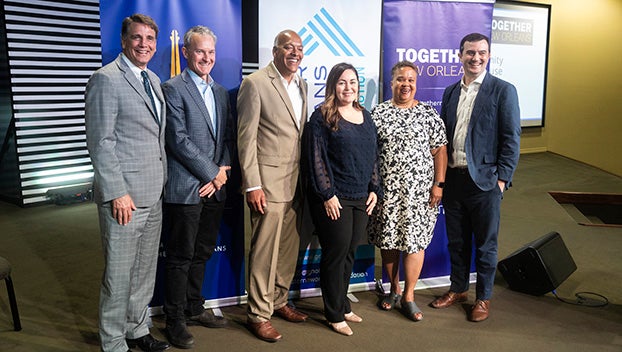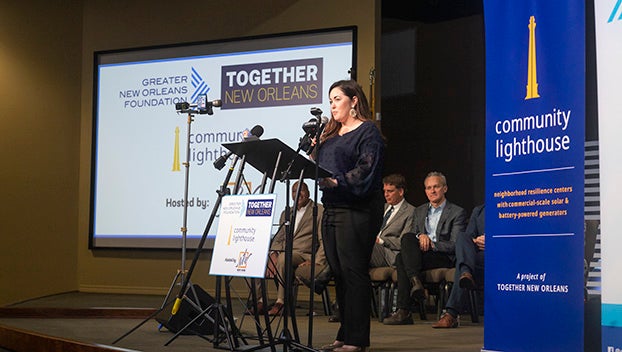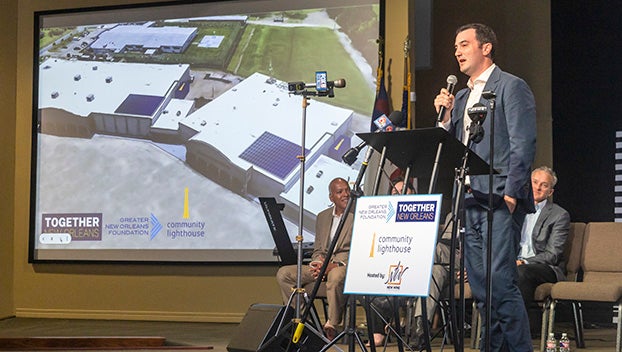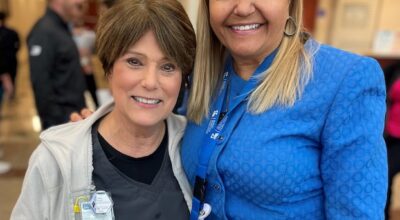$1 million grant will turn New Wine into a Community Lighthouse, keep power on during disasters
Published 4:35 pm Tuesday, May 24, 2022
|
Getting your Trinity Audio player ready...
|
LAPLACE — This morning, the Greater New Orleans Foundation announced a $1 million grant to New Wine Christian Fellowship and Together New Orleans as part of the Community Lighthouse project, an investment that will keep the lights on during future disasters.
New Wine will be part of a network of 85 to 100 congregations and community institutions in Southeast Louisiana equipped with commercial-scale solar power and back-up battery capacity.
The goals of the Community Lighthouse pilot program are to enhance resiliency during grid outages, disaster response capacity, local investment in renewable energy, and workforce training and jobs.
The long-term goal is to have a Community Lighthouse within a 15-minute walking distance of all Southeast Louisiana residents. In the event of a disaster or widespread power outage, this could provide the community with charging stations, cooling or heating stations, battery distribution, food preparation, and distribution of oxygen exchange and light medical equipment.
Pierre Moses, president of 127 Energy, said each Community Lighthouse will comprise a resilient micro-grid that can operate independently from the main grid for days on end during a disaster.
New Wine Christian Fellowship Pastor Neil Bernard and his team have been at the forefront of disaster response in St. John Parish, especially in the immediate aftermath of hurricanes Katrina, Isaac and Ida.
“We have been able to assist our residents by providing food and water, providing emergency relief supplies, and helping those families rebuild. Because of this partnership, now we will be able to do that at a whole new level,” Bernard said.
Matthew Candler, electricity reform team co-chair for Together New Orleans, said the cost of solar panels and battery back-up systems have dropped in price by roughly 80% over the last 10 years.
During the grant announcement, Candler told the audience that the average smartphone needs 10 watts of power. Collectively, all human beings on the planet use roughly 16 trillion watts of power each day. While this may sound like a lot, it’s a minute amount when compared to the 173 quadrillion watts of power produced by the sun each day.
“When I sit in my community of faith next to my neighbors and I hear a story of God providing something that is 10,000 times more than any of us will ever need, that is a story of abundance,” Candler said. “All we have to do is capture it, and we can turn in into love and service for our neighbors.”
Andy Kopplin, president and CEO of the Greater New Orleans Foundation was pleased to announce the $1 million grant, which he said will help churches and community institutions like New Wine meet residents’ most critical needs.
“Some of you may remember learning about Maslow’s hierarchy of needs, and we know those most fundamental needs have to be addressed first are physiological – access to food and water, shelter, rest. The tier above that is safety and security. Those two bottom tiers of the pyramid are the most important things we worry about post-disaster,” Kopplin said.
He added, “What we’re hoping to do with this grant is make sure the lights come back on first among those disaster-responding churches and nonprofit organizations so they have the resources not just to meet those immediate needs, but also to charge peoples’ phones, store food and ice more effectively and have cooling centers where they might be needed to keep people out of the heat.”
St. John Parish President Jaclyn Hotard said perseverance takes center stage after a disaster, and the only way to persevere through the darkness is with light. She believes implementing solar panels and a battery back-up system will be an important first step to more effectively relaying information after a disaster.
“We saw with Ida what not having electricity did for our residents. The inability for them to be able to get information from us in real time made an already devastating situation even worse. People in many instances were at home and didn’t even know where the basic services were,” Hotard said.
According to Hotard, it is better to be overprepared for the storm that doesn’t come than to be underprepared for the one that does. She said community partnerships are an important aspect of storm preparation.
“As we all know, there’s only so much government can do, and we rely on our faith-based communities, our nonprofits, to come in and fill those voids,” Hotard said.
The Community Lighthouse Program’s construction goal for 2022 is to establish 10 pilot locations. The total cost of the pilot phase is estimated at $4.6 million, and the current cost gap is $2.5 million.
The Department of Energy has selected Community Lighthouse as one of 14 projects nationally to receive technical support under the “Energy Storage for Social Equity” initiative. The project has also received unanimous support from the New Orleans City Council, a $500,000 grant for Lighthouse at CrescentCare, and a $150,000 grant for disaster response team development.
Construction is anticipated to start this year. While some smaller sites may be operational within a few months, pending supply chain challenges, larger Lighthouse sites like New Wine will likely take a minimum of six months to get up and running.
The workforce training and jobs component of the Community Lighthouse Project will include project labor agreements to hire local workers at living wages for all stages of the process, including:
- pre-installation, energy audit and weatherization (windows/glass workers and heat/frost insulation workers)
- Solar panel and battery storage installation, and ongoing maintenance (electrical workers and apprentices, building trades)







